Language and Literacy: Tracing Evolution, Analyzing Skills & Power
VerifiedAdded on 2023/06/11
|6
|1327
|462
Essay
AI Summary
This essay delves into the multifaceted aspects of language and literacy, beginning with an exploration of the historical evolution of the English language, influenced by colonialism and contact with other languages like Latin and Greek. It examines phonetic, grammatical, and lexical variations across different dialects, highlighting the impact of historical contexts such as the Renaissance and American influence. The essay further discusses the discursive level of language, drawing on Derrida's perspective on language as a means of control and power, and analyzes how texts from different eras reflect societal norms and power structures. Finally, it assesses essential literacy skills, including the ability to articulate complex language issues, produce original discursive works, and analyze texts to deconstruct and contextualize them within broader interpretive frameworks. Desklib offers this essay as a resource for students, alongside a wealth of study tools and past papers.
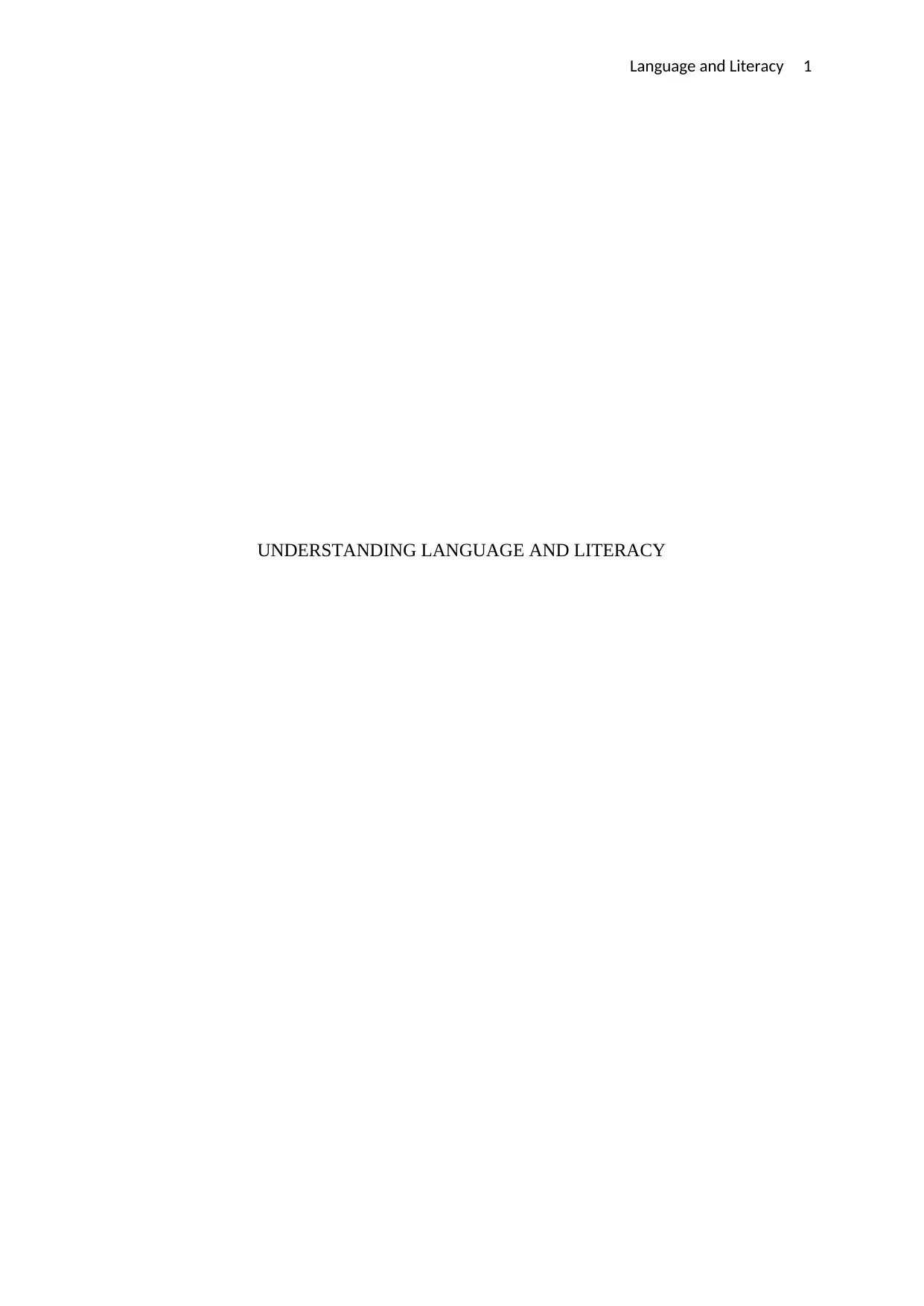
Language and Literacy 1
UNDERSTANDING LANGUAGE AND LITERACY
UNDERSTANDING LANGUAGE AND LITERACY
Paraphrase This Document
Need a fresh take? Get an instant paraphrase of this document with our AI Paraphraser
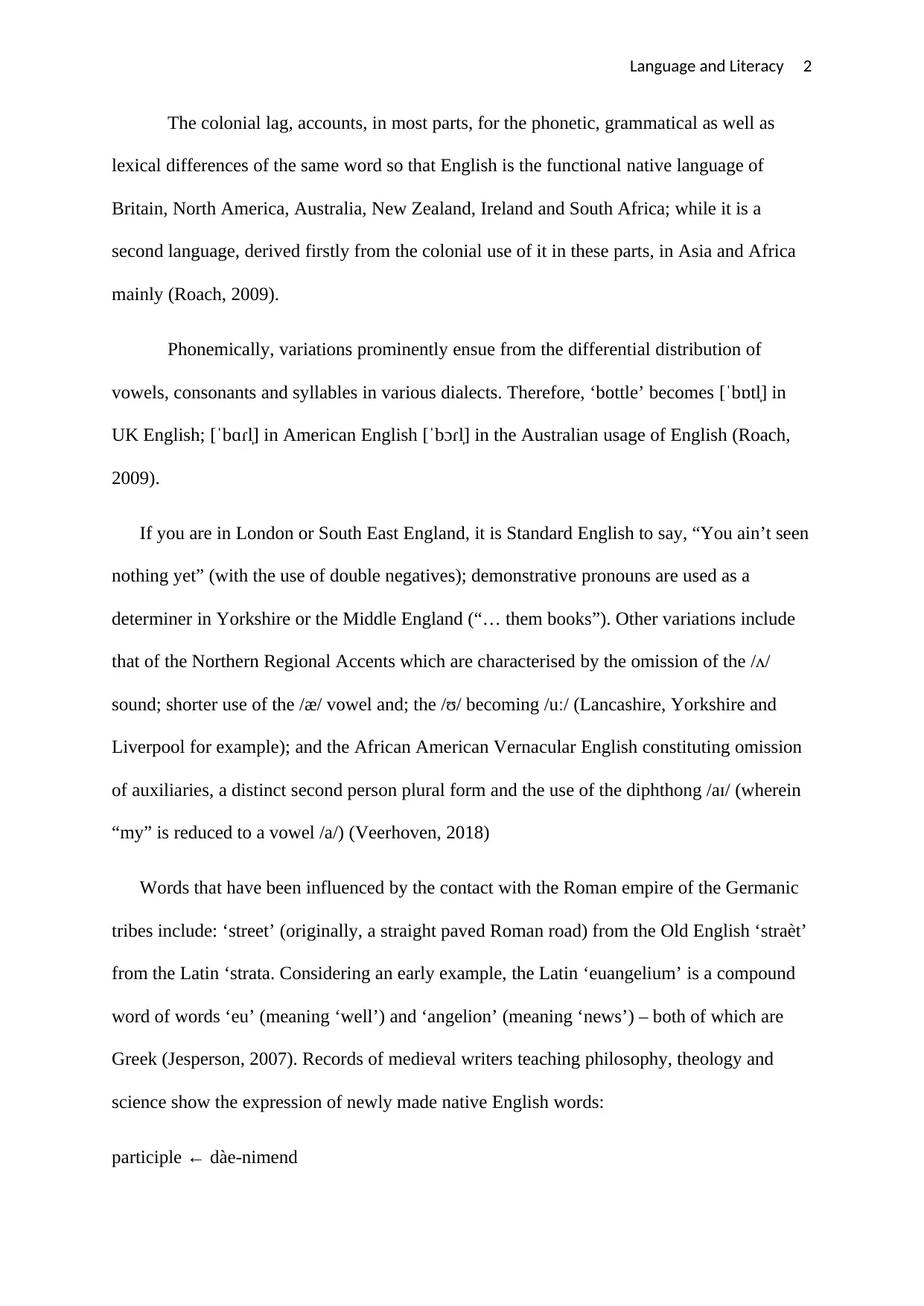
Language and Literacy 2
The colonial lag, accounts, in most parts, for the phonetic, grammatical as well as
lexical differences of the same word so that English is the functional native language of
Britain, North America, Australia, New Zealand, Ireland and South Africa; while it is a
second language, derived firstly from the colonial use of it in these parts, in Asia and Africa
mainly (Roach, 2009).
Phonemically, variations prominently ensue from the differential distribution of
vowels, consonants and syllables in various dialects. Therefore, ‘bottle’ becomes [ˈbɒtl̩] in
UK English; [ˈbɑɾl̩] in American English [ˈbɔɾl̩] in the Australian usage of English (Roach,
2009).
If you are in London or South East England, it is Standard English to say, “You ain’t seen
nothing yet” (with the use of double negatives); demonstrative pronouns are used as a
determiner in Yorkshire or the Middle England (“… them books”). Other variations include
that of the Northern Regional Accents which are characterised by the omission of the /ʌ/
sound; shorter use of the /æ/ vowel and; the /ʊ/ becoming /uː/ (Lancashire, Yorkshire and
Liverpool for example); and the African American Vernacular English constituting omission
of auxiliaries, a distinct second person plural form and the use of the diphthong /aɪ/ (wherein
“my” is reduced to a vowel /a/) (Veerhoven, 2018)
Words that have been influenced by the contact with the Roman empire of the Germanic
tribes include: ‘street’ (originally, a straight paved Roman road) from the Old English ‘straèt’
from the Latin ‘strata. Considering an early example, the Latin ‘euangelium’ is a compound
word of words ‘eu’ (meaning ‘well’) and ‘angelion’ (meaning ‘news’) – both of which are
Greek (Jesperson, 2007). Records of medieval writers teaching philosophy, theology and
science show the expression of newly made native English words:
participle ← dàe-nimend
The colonial lag, accounts, in most parts, for the phonetic, grammatical as well as
lexical differences of the same word so that English is the functional native language of
Britain, North America, Australia, New Zealand, Ireland and South Africa; while it is a
second language, derived firstly from the colonial use of it in these parts, in Asia and Africa
mainly (Roach, 2009).
Phonemically, variations prominently ensue from the differential distribution of
vowels, consonants and syllables in various dialects. Therefore, ‘bottle’ becomes [ˈbɒtl̩] in
UK English; [ˈbɑɾl̩] in American English [ˈbɔɾl̩] in the Australian usage of English (Roach,
2009).
If you are in London or South East England, it is Standard English to say, “You ain’t seen
nothing yet” (with the use of double negatives); demonstrative pronouns are used as a
determiner in Yorkshire or the Middle England (“… them books”). Other variations include
that of the Northern Regional Accents which are characterised by the omission of the /ʌ/
sound; shorter use of the /æ/ vowel and; the /ʊ/ becoming /uː/ (Lancashire, Yorkshire and
Liverpool for example); and the African American Vernacular English constituting omission
of auxiliaries, a distinct second person plural form and the use of the diphthong /aɪ/ (wherein
“my” is reduced to a vowel /a/) (Veerhoven, 2018)
Words that have been influenced by the contact with the Roman empire of the Germanic
tribes include: ‘street’ (originally, a straight paved Roman road) from the Old English ‘straèt’
from the Latin ‘strata. Considering an early example, the Latin ‘euangelium’ is a compound
word of words ‘eu’ (meaning ‘well’) and ‘angelion’ (meaning ‘news’) – both of which are
Greek (Jesperson, 2007). Records of medieval writers teaching philosophy, theology and
science show the expression of newly made native English words:
participle ← dàe-nimend
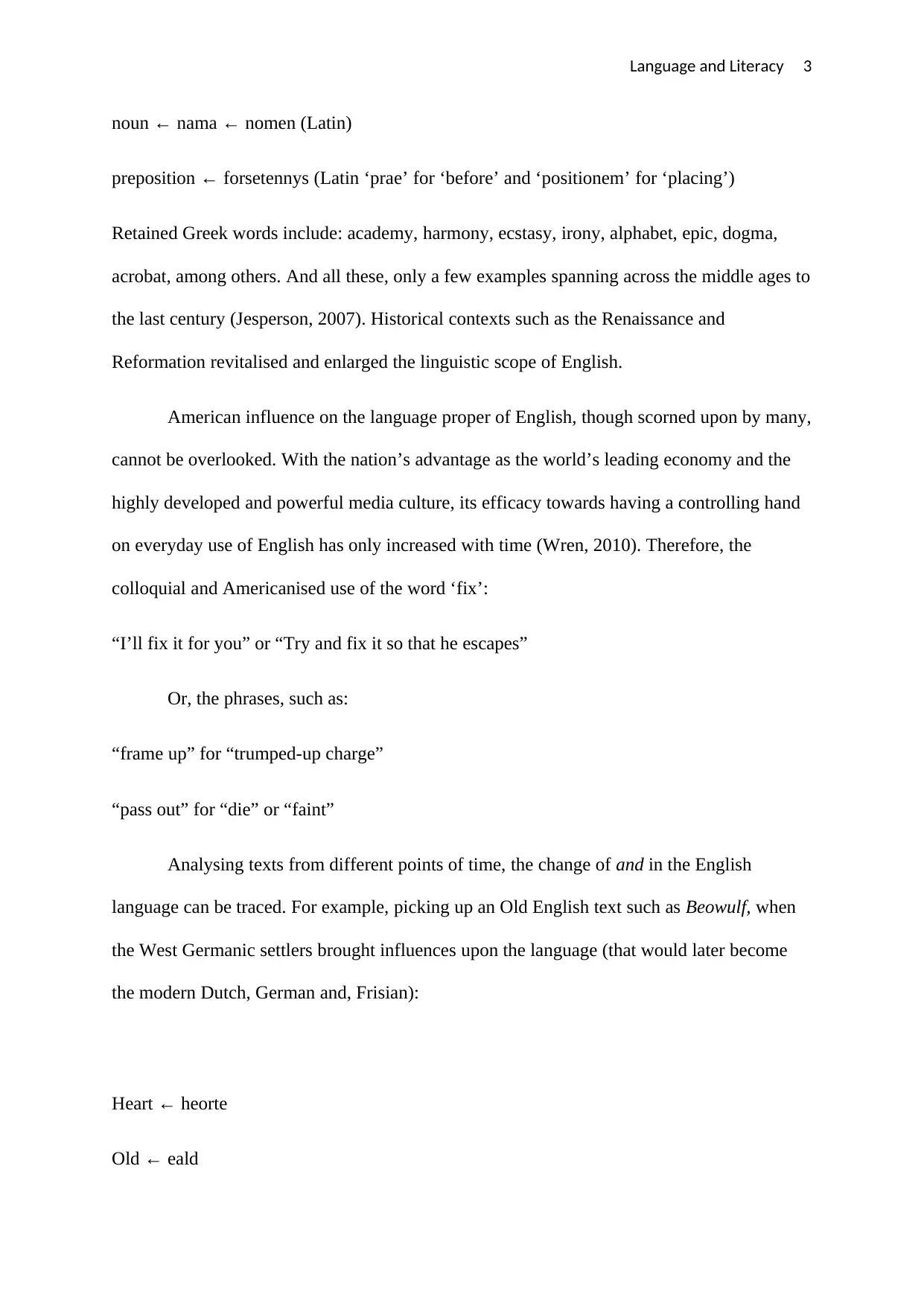
Language and Literacy 3
noun ← nama ← nomen (Latin)
preposition ← forsetennys (Latin ‘prae’ for ‘before’ and ‘positionem’ for ‘placing’)
Retained Greek words include: academy, harmony, ecstasy, irony, alphabet, epic, dogma,
acrobat, among others. And all these, only a few examples spanning across the middle ages to
the last century (Jesperson, 2007). Historical contexts such as the Renaissance and
Reformation revitalised and enlarged the linguistic scope of English.
American influence on the language proper of English, though scorned upon by many,
cannot be overlooked. With the nation’s advantage as the world’s leading economy and the
highly developed and powerful media culture, its efficacy towards having a controlling hand
on everyday use of English has only increased with time (Wren, 2010). Therefore, the
colloquial and Americanised use of the word ‘fix’:
“I’ll fix it for you” or “Try and fix it so that he escapes”
Or, the phrases, such as:
“frame up” for “trumped-up charge”
“pass out” for “die” or “faint”
Analysing texts from different points of time, the change of and in the English
language can be traced. For example, picking up an Old English text such as Beowulf, when
the West Germanic settlers brought influences upon the language (that would later become
the modern Dutch, German and, Frisian):
Heart ← heorte
Old ← eald
noun ← nama ← nomen (Latin)
preposition ← forsetennys (Latin ‘prae’ for ‘before’ and ‘positionem’ for ‘placing’)
Retained Greek words include: academy, harmony, ecstasy, irony, alphabet, epic, dogma,
acrobat, among others. And all these, only a few examples spanning across the middle ages to
the last century (Jesperson, 2007). Historical contexts such as the Renaissance and
Reformation revitalised and enlarged the linguistic scope of English.
American influence on the language proper of English, though scorned upon by many,
cannot be overlooked. With the nation’s advantage as the world’s leading economy and the
highly developed and powerful media culture, its efficacy towards having a controlling hand
on everyday use of English has only increased with time (Wren, 2010). Therefore, the
colloquial and Americanised use of the word ‘fix’:
“I’ll fix it for you” or “Try and fix it so that he escapes”
Or, the phrases, such as:
“frame up” for “trumped-up charge”
“pass out” for “die” or “faint”
Analysing texts from different points of time, the change of and in the English
language can be traced. For example, picking up an Old English text such as Beowulf, when
the West Germanic settlers brought influences upon the language (that would later become
the modern Dutch, German and, Frisian):
Heart ← heorte
Old ← eald
⊘ This is a preview!⊘
Do you want full access?
Subscribe today to unlock all pages.

Trusted by 1+ million students worldwide
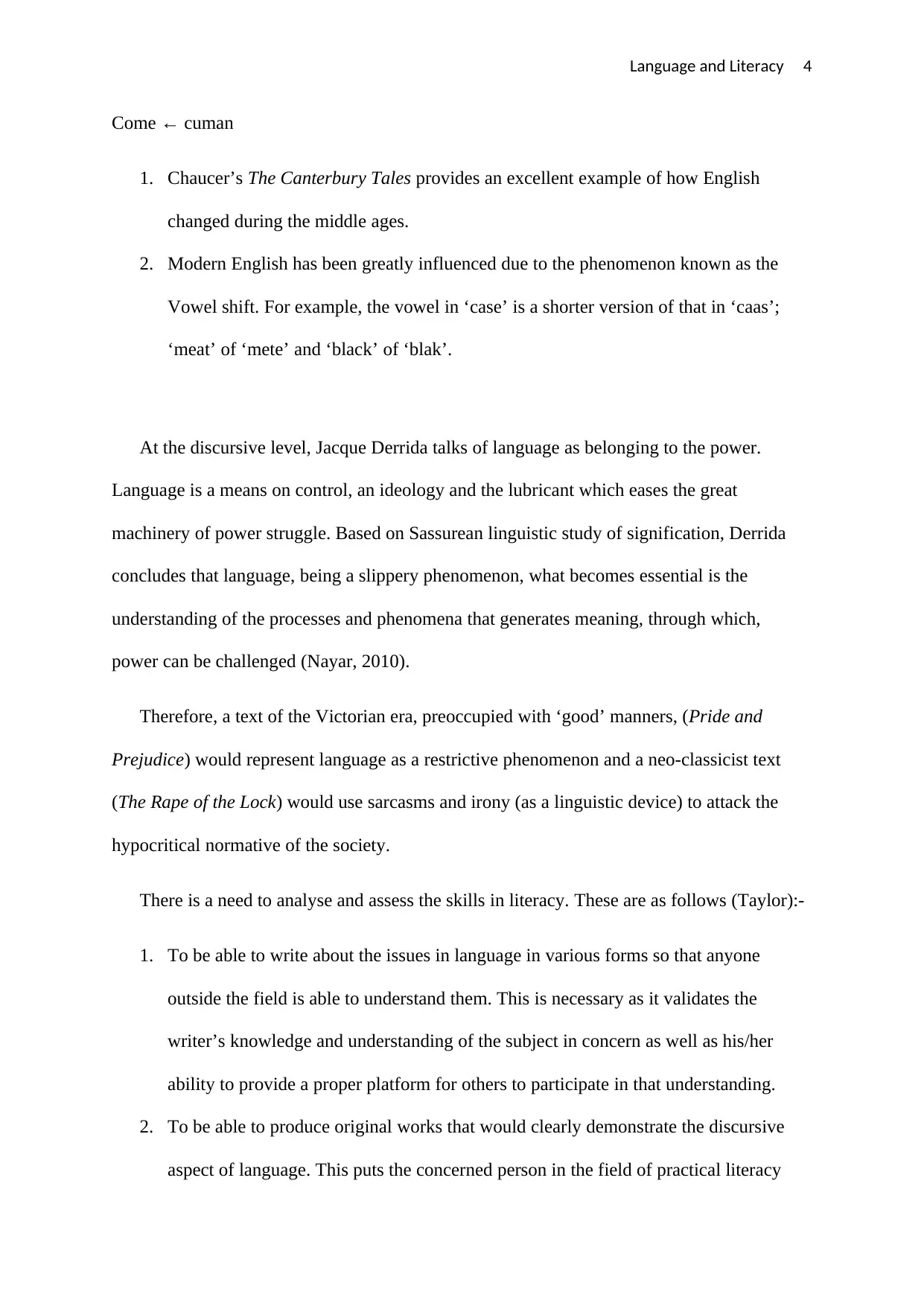
Language and Literacy 4
Come ← cuman
1. Chaucer’s The Canterbury Tales provides an excellent example of how English
changed during the middle ages.
2. Modern English has been greatly influenced due to the phenomenon known as the
Vowel shift. For example, the vowel in ‘case’ is a shorter version of that in ‘caas’;
‘meat’ of ‘mete’ and ‘black’ of ‘blak’.
At the discursive level, Jacque Derrida talks of language as belonging to the power.
Language is a means on control, an ideology and the lubricant which eases the great
machinery of power struggle. Based on Sassurean linguistic study of signification, Derrida
concludes that language, being a slippery phenomenon, what becomes essential is the
understanding of the processes and phenomena that generates meaning, through which,
power can be challenged (Nayar, 2010).
Therefore, a text of the Victorian era, preoccupied with ‘good’ manners, (Pride and
Prejudice) would represent language as a restrictive phenomenon and a neo-classicist text
(The Rape of the Lock) would use sarcasms and irony (as a linguistic device) to attack the
hypocritical normative of the society.
There is a need to analyse and assess the skills in literacy. These are as follows (Taylor):-
1. To be able to write about the issues in language in various forms so that anyone
outside the field is able to understand them. This is necessary as it validates the
writer’s knowledge and understanding of the subject in concern as well as his/her
ability to provide a proper platform for others to participate in that understanding.
2. To be able to produce original works that would clearly demonstrate the discursive
aspect of language. This puts the concerned person in the field of practical literacy
Come ← cuman
1. Chaucer’s The Canterbury Tales provides an excellent example of how English
changed during the middle ages.
2. Modern English has been greatly influenced due to the phenomenon known as the
Vowel shift. For example, the vowel in ‘case’ is a shorter version of that in ‘caas’;
‘meat’ of ‘mete’ and ‘black’ of ‘blak’.
At the discursive level, Jacque Derrida talks of language as belonging to the power.
Language is a means on control, an ideology and the lubricant which eases the great
machinery of power struggle. Based on Sassurean linguistic study of signification, Derrida
concludes that language, being a slippery phenomenon, what becomes essential is the
understanding of the processes and phenomena that generates meaning, through which,
power can be challenged (Nayar, 2010).
Therefore, a text of the Victorian era, preoccupied with ‘good’ manners, (Pride and
Prejudice) would represent language as a restrictive phenomenon and a neo-classicist text
(The Rape of the Lock) would use sarcasms and irony (as a linguistic device) to attack the
hypocritical normative of the society.
There is a need to analyse and assess the skills in literacy. These are as follows (Taylor):-
1. To be able to write about the issues in language in various forms so that anyone
outside the field is able to understand them. This is necessary as it validates the
writer’s knowledge and understanding of the subject in concern as well as his/her
ability to provide a proper platform for others to participate in that understanding.
2. To be able to produce original works that would clearly demonstrate the discursive
aspect of language. This puts the concerned person in the field of practical literacy
Paraphrase This Document
Need a fresh take? Get an instant paraphrase of this document with our AI Paraphraser
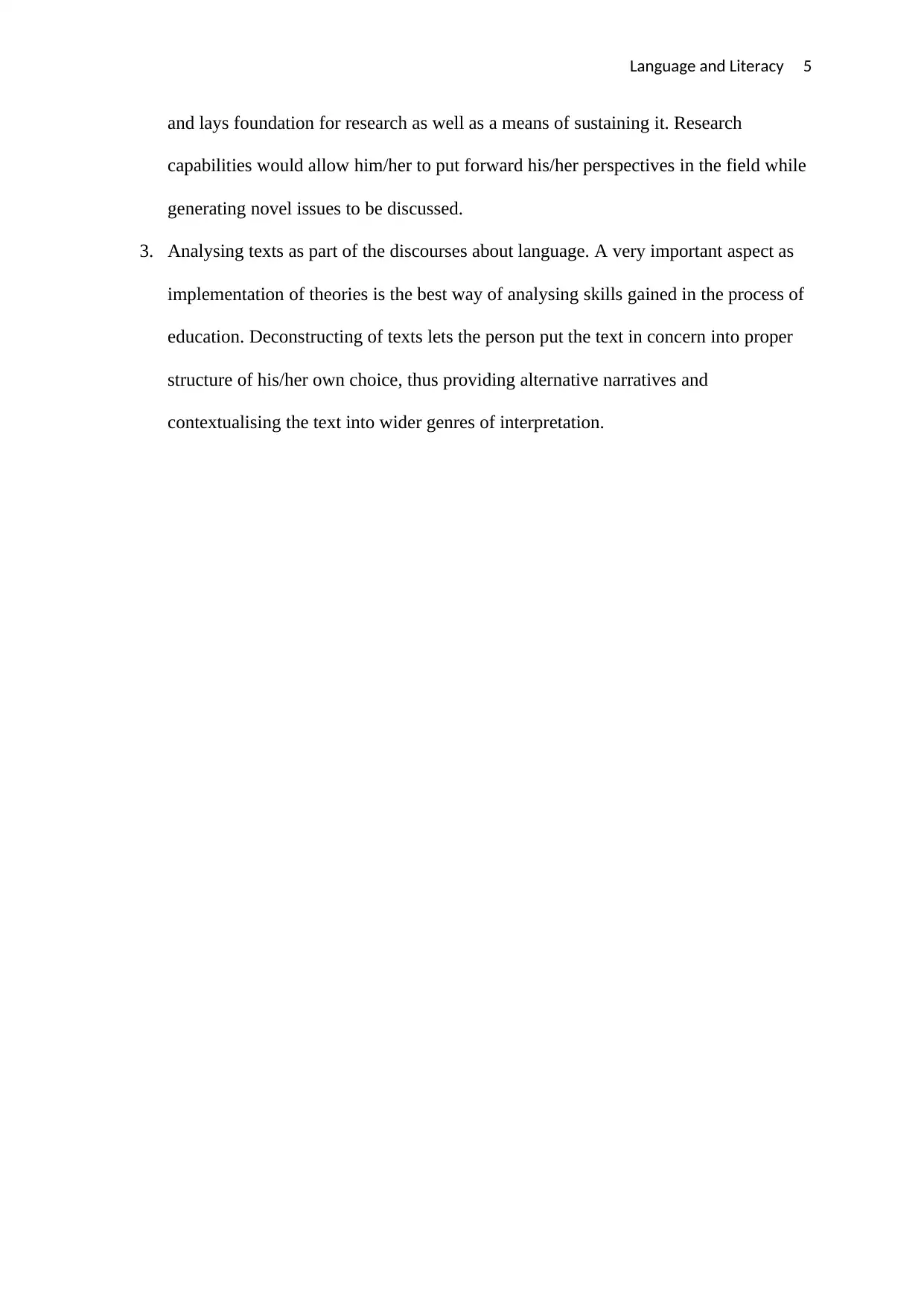
Language and Literacy 5
and lays foundation for research as well as a means of sustaining it. Research
capabilities would allow him/her to put forward his/her perspectives in the field while
generating novel issues to be discussed.
3. Analysing texts as part of the discourses about language. A very important aspect as
implementation of theories is the best way of analysing skills gained in the process of
education. Deconstructing of texts lets the person put the text in concern into proper
structure of his/her own choice, thus providing alternative narratives and
contextualising the text into wider genres of interpretation.
and lays foundation for research as well as a means of sustaining it. Research
capabilities would allow him/her to put forward his/her perspectives in the field while
generating novel issues to be discussed.
3. Analysing texts as part of the discourses about language. A very important aspect as
implementation of theories is the best way of analysing skills gained in the process of
education. Deconstructing of texts lets the person put the text in concern into proper
structure of his/her own choice, thus providing alternative narratives and
contextualising the text into wider genres of interpretation.
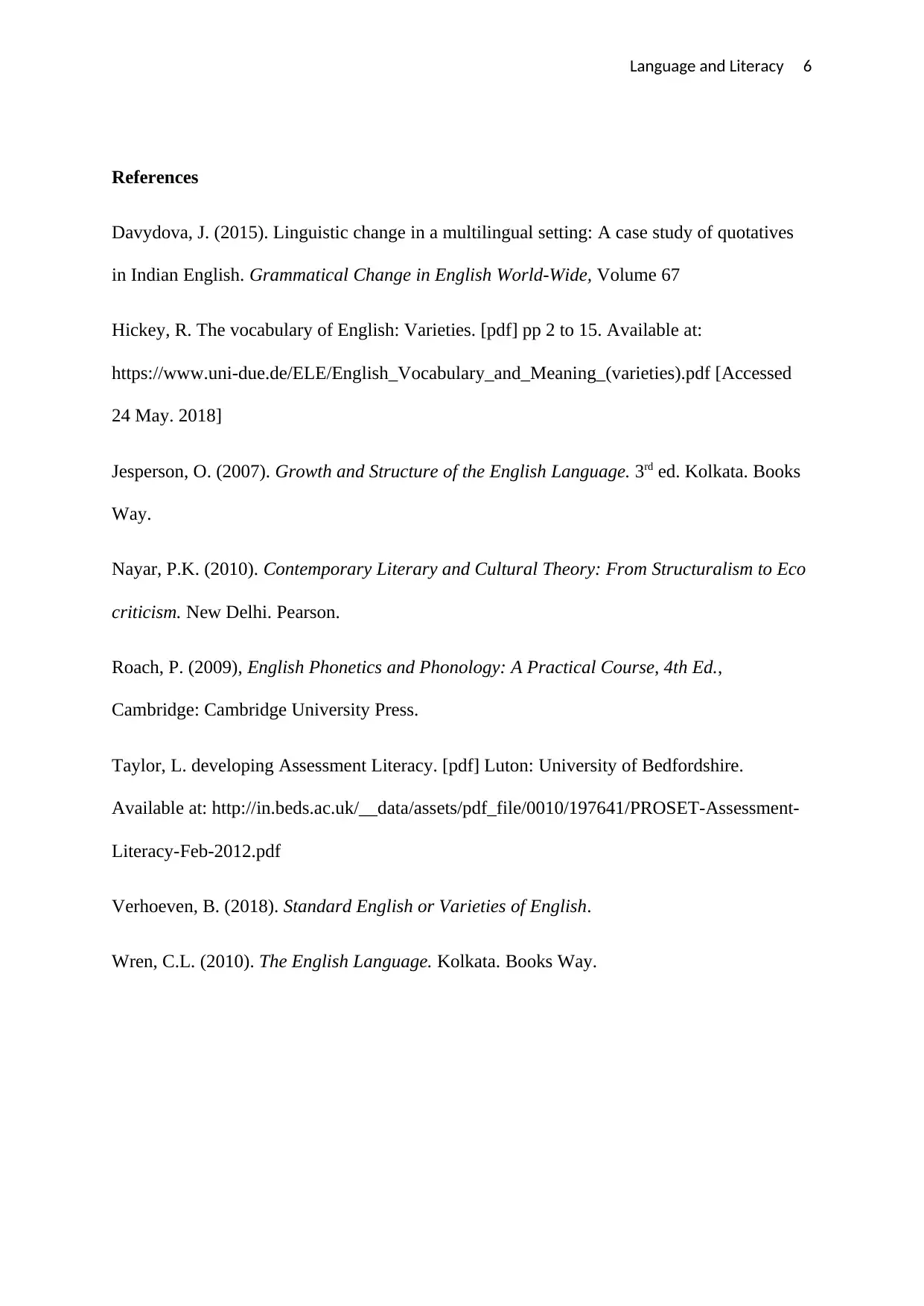
Language and Literacy 6
References
Davydova, J. (2015). Linguistic change in a multilingual setting: A case study of quotatives
in Indian English. Grammatical Change in English World-Wide, Volume 67
Hickey, R. The vocabulary of English: Varieties. [pdf] pp 2 to 15. Available at:
https://www.uni-due.de/ELE/English_Vocabulary_and_Meaning_(varieties).pdf [Accessed
24 May. 2018]
Jesperson, O. (2007). Growth and Structure of the English Language. 3rd ed. Kolkata. Books
Way.
Nayar, P.K. (2010). Contemporary Literary and Cultural Theory: From Structuralism to Eco
criticism. New Delhi. Pearson.
Roach, P. (2009), English Phonetics and Phonology: A Practical Course, 4th Ed.,
Cambridge: Cambridge University Press.
Taylor, L. developing Assessment Literacy. [pdf] Luton: University of Bedfordshire.
Available at: http://in.beds.ac.uk/__data/assets/pdf_file/0010/197641/PROSET-Assessment-
Literacy-Feb-2012.pdf
Verhoeven, B. (2018). Standard English or Varieties of English.
Wren, C.L. (2010). The English Language. Kolkata. Books Way.
References
Davydova, J. (2015). Linguistic change in a multilingual setting: A case study of quotatives
in Indian English. Grammatical Change in English World-Wide, Volume 67
Hickey, R. The vocabulary of English: Varieties. [pdf] pp 2 to 15. Available at:
https://www.uni-due.de/ELE/English_Vocabulary_and_Meaning_(varieties).pdf [Accessed
24 May. 2018]
Jesperson, O. (2007). Growth and Structure of the English Language. 3rd ed. Kolkata. Books
Way.
Nayar, P.K. (2010). Contemporary Literary and Cultural Theory: From Structuralism to Eco
criticism. New Delhi. Pearson.
Roach, P. (2009), English Phonetics and Phonology: A Practical Course, 4th Ed.,
Cambridge: Cambridge University Press.
Taylor, L. developing Assessment Literacy. [pdf] Luton: University of Bedfordshire.
Available at: http://in.beds.ac.uk/__data/assets/pdf_file/0010/197641/PROSET-Assessment-
Literacy-Feb-2012.pdf
Verhoeven, B. (2018). Standard English or Varieties of English.
Wren, C.L. (2010). The English Language. Kolkata. Books Way.
⊘ This is a preview!⊘
Do you want full access?
Subscribe today to unlock all pages.

Trusted by 1+ million students worldwide
1 out of 6
Your All-in-One AI-Powered Toolkit for Academic Success.
+13062052269
info@desklib.com
Available 24*7 on WhatsApp / Email
![[object Object]](/_next/static/media/star-bottom.7253800d.svg)
Unlock your academic potential
Copyright © 2020–2025 A2Z Services. All Rights Reserved. Developed and managed by ZUCOL.